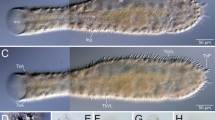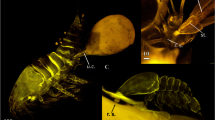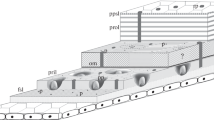Summary
The structure of the integument ofEchiniscus testudo (Heterotardigrada),Milnesium tardigradum, Hypsibius oberhaeuseri andMacrobiotus hufelandi (Eutardigrada) was studied by light and electron microscopy. In all species the cuticle consists of 6–8 layers and can adequately be described following the terminology of Baccetti and Rosati (1971). This perhaps does not apply toE. testudo.
InE. testudo the inner sclerotized epicuticle reveals a labyrinthine structure due to lacunae with numerous channels of about 150 Å in diameter. The central canals in the depressions of the dorsal plates have a diameter of 500 Å. The outer epicuticle of the ventral cuticle is formed by several layers. Basally there is a tubular layer of channels and an almost reduced epicuticle. Thus the permeability of the cuticle is supposed to be altered. In the intracuticle vertically oriented filaments occur. The inner layer of the intracuticle and the wax-layer cannot be properly distinguished. The one-layered epidermis contains many lipid droplets, ribosomes and rough ER. Some of the cells are rather electron-dense.
Peculiar cuticular structures inM. hufelandi appear as cup-shaped depressions of the epicuticle, and here the inner epicuticle is absent. A similarly typical feature is the structured and sculptured dorsal and lateral epicuticle ofH. oberhaeuseri and the channels of the epicuticle inM. tardigradum. In all species investigated there are no pore canals in the procuticle.
InM. hufelandi there is a single layer of epidermal cells, which contain many osmiophilic grana ensheathed by membranes. These grana cause the colour of the animal. Some of the cells contain more organelles and ribosomes and show a strong contrast.
In spite of some cuticular peculiarities inE. testudo, perhaps this Heterotardigrade species fits into the general pattern of cuticle morphology of Tardigrada.
Zusammenfassung
Licht- und elektronenmikroskopische Untersuchungen am Integument vonEchiniscus testudo (Heterotardigrada),Milnesium tardigradum, Hypsibius oberhaeuseri undMacrobiotus hufelandi (Eutardigrada) lassen acht, mindestens jedoch sechs Schichten erkennen, die in Anlehnung an Baccetti und Rosati (1971) benannt werden, wobei eine Homologie beiE. testudo nicht sicher ist.
BeiE. testudo bildet die innere sklerotisierte Epicuticula ein Hohlraumsystem, dessen Wände von ca. 150 Å breiten Kanälen durchzogen werden. Die dorsalen Einsenkungen der Panzerplatten besitzen einen zentralen 500 Å breiten Kanal. Ventral ist die äußere Epicuticula mehrfach geschichtet. Ein darunterliegender Röhrchensaum und die weitgehend reduzierte innere Epicuticula lassen andere Permeabilitätseigenschaften vermuten. Die Intracuticula zeigt vertikale Filamente. Wachsschicht und innere Lage der Intracuticula sind morphologisch nicht eindeutig zu identifizieren. Die einschichtige Epidermis ist reich an Lipidtropfen, freien Ribosomen und granulärem endoplasmatischem Reticulum. Manche Zellen sind kontrastreicher.
Besondere Cuticula-Bildungen der drei Eutardigraden sind die epicuticulären Einsenkungen vonM. hufelandi, in deren Bereich die innere Epicuticula fehlt, die dorsale und laterale Skulpturierung vonH. oberhaeuseri, die eine Bildung der Epicuticula ist, und die epicuticulären Kanäle vonM. tardigradum. Die Proticula aller untersuchten Tardigraden-Arten besitzt keine Porenkanäle.
Die Epidermis vonM. hufelandi besteht aus einem einschichtigen Epithel. Seine Zellen enthalten zahlreiche membranbegrenzte osmiophile Einschlüsse, die die Färbung der Tiere bedingen. Einzelne Zellen fallen durch ihren hohen Kontrast und zahlreichere Organellen auf.
Die Cuticula der Eutardigraden zeigt in allen Fällen eine morphologisch vergelichbare Schichtenfolge. Die Cuticula vonE. testudo, die Besonderheiten aufweist, kann jedoch aufgrund charakteristischer Merkmale (z. B. die äußere Lage der Intracuticula) vielleicht in den Vergleich einbezogen werden.
Similar content being viewed by others
Literatur
Baccetti, B., Rosati, F.: Electron microscopy on tardigrades. 1. Connective tissue. J. Submicr. Cytol.1, 197–205 (1969).
Baccetti, B., Rosati, F.: Electron microscopy on tardigrades. III. The integument. J. Ultrastruct. Res.34, 214–243 (1971).
Baumann, H.: Die Anabiose der Tardigraden. Zool. Jb. Syst.45, 501–556 (1922).
Beament, J. W. L.: The water relations of insect cuticle. Biol. Rev.36, 281–320 (1961).
Crowe, J. H.: Anhydrobiosis: An unsolved problem. Amer. Naturalist105, 563–574 (1971).
Crowe, J. H.: Evaporative water loss by the tardigradeMacrobiotus areolatus under controlled relative humidities. Biol. Bull.142, 407–416 (1972).
Crowe, J. H., Newell, J. M., Thomson, W. W.:Echiniscus viridis (Tardigrada): Fine structure of the cuticle. Trans. Amer. micr. Soc.89, 316–325 (1970).
Crowe, J. H., Newell, J. M., Thomson, W. W.: Fine structure and chemical composition of the cuticle of the tardigrade,Macrobiotus areolatus Murray. J. Microscopie11, 107–120 (1971a).
Crowe, J. H., Newell, J. M., Thomson, W. W.: Cuticle formation in the tardigrade,Macrobiotus areolatus Murray. J. Microscopie11, 121–132 (1971b).
Edney, E. B.: The water relations of terrestrial arthropods. Cambridge: University Press 1957.
Füller, H.: Dichroitische Anfärbung von Chitin mit Thiazinrot, ein histochemischer Chitinnachweis. Zool. Anz.174, 125–131 (1965).
Greven, H.: Faunistisch-ökologische und funktionsmorphologische Untersuchungen an heimischen Tardigraden. Diss. Münster 1971a.
Greven, H.: Zur Feinstruktur der inneren Epicuticula vonEchiniscus testudo. Naturwissenschaften58, 367–368 (1971b).
Greven, H.: Zur Morphologie der Tardigraden. Rasterelektronenmikroskopische Untersuchungen anMacrobiotus hufelandi undEchiniscus testudo. forma et functio4, 283–302 (1971c).
Greven, H.: Tardigraden des nördlichen Sauerlandes. Zool. Anz. (im Druck).
Greven H., Kuhlmann, D.: Die Struktur des Nervengewebes vonMacrobiotus hufelandi C.A.S. Schultze (Tardigrada). Z. Zellforsch.132, 131–146 (1972).
Hackmann, R. H.: Chemistry of the insect cuticle. In: Rockstein, The physiology of insecta, vol. III. New York: Academic Press Inc. 1964.
Hess, R. T., Menzell, D. B.: The fine structure of the epicuticular particles ofEnchytraesus fragmentosus. J. Ultrastruct. Res.19, 487–497 (1967).
Hirsch, Th. v., Boellard, J. W.: Methacrylsäureester als Einbettungsmittel in der Histologie. Z. wiss. Mikr.64, 24–29 (1959).
Krall, J. F.: The cuticle and epidermal cells ofDero obtusa (Family Naididae). J. Ultrastruct. Res.25, 84–93 (1968).
Lavallard, R.: Etude au microscope électronique de l'épithelium tegumentaire chezPeripatus acacioi, Marcus et Marcus. C. R. Acad. Sci. (Paris)260, 965–968 (1965).
Locke, M.: The structure and formation of the integument in insects. In: Rockstein, The physiology of insecta, vol. III. New York: Academic Press Inc. 1964.
Locke, M.: The structure of an epidermal cell during the development of the protein epicuticle and the uptake of molting fluid in an insect. J. Morph.127, 7–39 (1969).
Marcus, E.: Tardigrada. In: Bronns Klassen und Ordnungen des Tierreichs, Bd. 5, Abtlg. IV, Buch 3. Leipzig: Akademische Verlagsgesellschaft 1929.
Morris, J. E., Afzelius, B. A.: The structure of the shell and outer membranes in encystedArtemia salina embryos during cryptobiosis and development. J. Ultrastruct. Res.20, 244–259 (1967).
Noirot, Ch., Noirot-Timothee, C.: La cuticle proctodéale des insectes. I. Ultrastructure compareé. Z. Zellforsch.101, 477–509 (1969).
Noirot, Ch., Noirot-Timothee, C.: La cuticule proctodéale des insectes. II. Formation durant la mue. Z. Zellforsch.113, 361–387 (1971).
Palade, G. E.: A study of fixation for electron microscopy. J. exp. Med.95, 285–297 (1952).
Ramazzotti, G.: Il phylum Tardigrada (2. ed.). Memorie Ist. ital. Idrobiol.28, 1–732 (1972).
Richards, A. G.: The integument of arthropods. Minneapolis: University of Minnesota Press 1951.
Richards, A. G.: Sclerotization and the localization of brown and black colors in insects. Zool. Jb. Anat.84, 25–62 (1967).
Richardson, K. C., Jarett, L., Finke, E. H.: Embedding in epoxy resin for ultrathin sectioning in electron microscopy. Stain Technol.35, 313–323 (1960).
Robson, E.: The cuticle ofPeripatopsis moseleyi. Quart. J. micr. Sci.105, 281–299 (1964).
Romeis, B.: Mikroskopische Technik. München: Oldenbourg 1968.
Rosati, F.: Ricerche di microscopia elettronica sui Tardigradi. 2. I globuli cavitari. Atti Accad. Fisiocr. Sez. med.-fis. Siena17, 1439–1452 (1968).
Ruthmann, A.: Methoden der Zellforschung. Stuttgart: Frankh'sche Verlagshandlung 1966.
Seifert, G.: Die Cuticula vonPolyxenus lagurus L. (Diplopoda, Pselaphognatha). Z. Morph. Ökol. Tiere59, 42–53 (1967).
Sewell, M. T.: The histology and histochemistry of the cuticle of a spider,Tegenaria domestica (L.). Ann. entomol Soc. Amer.48, 107–118 (1955).
Weglarska, B.: On the encystation in Tardigrada I. Zoologica Pol.8, 315–324 (1957).
Wood, R. L., Luft, J. H.: The influence of buffer systems on fixation with osmium tetroxide. J. Ultrastruct. Res.12, 22–45 (1965).
Wright, K. A., Hope, W. D.: Elaborations of the cuticle ofAcanthonchus duplicatus Wieser 1959 (Nematoda: Cyatholaimidae) as revealed by light and electron microscopy. Canad. J. Zool.46, 1005–1011 (1968).
Author information
Authors and Affiliations
Additional information
Veränderter Teil einer Dissertation des Fachbereichs Biologie der Universität Münster. Die Arbeit wurde von Herrn Prof. Dr. R. Altevogt angeregt.
Rights and permissions
About this article
Cite this article
Greven, H. Vergleichende Untersuchungen am Integument von Hetero- und Eutardigraden. Z.Zellforsch 135, 517–538 (1972). https://doi.org/10.1007/BF00583434
Received:
Issue Date:
DOI: https://doi.org/10.1007/BF00583434




